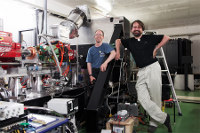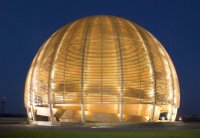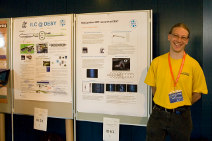International collaborators at ATF2
–Notre Dame and Oxford University–

The MONALISA team from Oxford University at ATF2. |
At the Accelerator Test Facility (ATF) at KEK, researchers around the world are testing the feasibility of their accelerator techniques. Because the ILC beams are very small, very accurate and precise beam diagnostic measurements are required. Physicists from Notre Dame University, US, and Oxford University, UK, visited ATF2 in July to make tests relevant to beam diagnostic measurement.
Read more...
-- Hiroto Oishi |
|
 |
A grand tuning voyage
Two cavity tuning machines on their way to Fermilab

These cavity tuning machines will find a loving new home at Fermilab and KEK. |
When groups from different countries work together the usual procedure is to send the people to the machines they are working on. A team of engineers and technicians from DESY, Fermilab and KEK decided to do the exact opposite: they sent the machines to the people. On 3 August two machines constructed at DESY embarked on a voyage to Fermilab in the US.
Read more...
-- Gerrit Hörentrup, DESY |
 |
|
|
 |
From Cornell University Chronicle
24 August 2009
Cornell electron storage ring is test case for International Linear Collider
Scientists working on the proposed International Linear Collider (ILC) know exactly what they want it to do — collide tightly focused beams of subatomic particles with unprecedented energy, recreating conditions during the big bang and unlocking the mysteries of the universe's origins.
Read more... |
|
From CERN bulletin
24 August 2009
The complexity behind the date
...So, what actually goes on behind the scenes in timing and planning all the work on one of the most complex scientific instruments ever built?
Read more... |
|
From ars technica
21 August 2009
40-year-old data tackles very modern physics problem
Looking back at old data allows physicists to place new constraints on physics beyond the standard model and propose a new approach to uncovering evidence of new physics.
Read more... |
|
From symmetry breaking
21 August 2009
Groove to the physics mix tape
With a quick look through iTunes you might notice that a lot of popular musicians have taken a cue from physics.
Read more... |
|
From symmetry magazine
August
Superconducting Technology, Chicago Style
...The design of the prototype accelerator at Fermilab’s SRF test facility is similar to the one proposed for the International Linear Collider, a proposed electron-positron collider. Each cavity will be a necklace of nine cells, and eight of these cavities will fit into a cryomodule. When complete, Fermilab’s prototype accelerator will have six cryomodules.
Read more... |
|
|
 |
The beauty of international collaboration
Today's issue features a Director's Corner from Jean-Pierre Delahaye, CLIC study leader and latest addition to the GDE Executive Committee.

The Globe of Science and Innovation, CERN's public landmark. Image: CERN. |
As a newcomer to the ILC GDE Executive Committee (EC), which I feel is a great honour, I have been kindly (but firmly) invited to write one of the monthly Directors' Corners for ILC NewsLine on a subject of my own choice. I therefore decided to write a few words on my favourite subject, the beauty of International Collaboration.
Read more...
-- Jean-Pierre Delahaye
Director's Corner Archive |
 |
|
|
 |
Prize for ILC poster

During last week's Lepton Photon conference in Hamburg, a poster presented by Sebastian Aderhold from DESY won one of the three prizes awarded by the Association of the Friends and Sponsors of DESY. A total of 73 posters were on show, and Sebastian's on "High-Gradient SRF Research at DESY" won in the category “Experimental Methods and Projects". See the website for the other winning posters.
|
|
arXiv preprints
0908.3019
The LCFIVertex package: vertexing, flavour tagging and vertex charge reconstruction with an ILC vertex detector
0908.2951
Anomalous Quartic Gauge Couplings from Six Quark Production
0908.2898
Neutral Higgs-pair production at Linear Colliders within the general 2HDM: quantum effects and triple Higgs boson self-interactions
|
|

